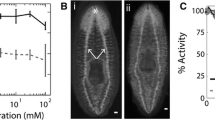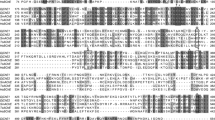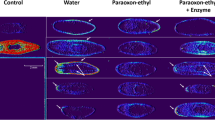Abstract
Organophosphorus pesticides (OPs) are a chemically diverse class of insecticides that inhibit acetylcholinesterase (AChE). Many OPs require bioactivation to their active oxon form via cytochrome P450 to effectively inhibit AChE. OP toxicity can be mitigated by detoxification reactions performed by carboxylesterase and paraoxonase. The relative extent of bioactivation to detoxification varies among individuals and between species, leading to differential susceptibility to OP toxicity. Because of these species differences, it is imperative to characterize OP metabolism in model systems used to assess OP toxicity. We have shown that the asexual freshwater planarian Dugesia japonica is a suitable model to assess OP neurotoxicity and developmental neurotoxicity via rapid, automated testing of adult and developing organisms in parallel using morphological and behavioral endpoints. D. japonica has two cholinesterase enzymes with intermediate properties between AChE and butyrylcholinesterase that are sensitive to OP inhibition. Here, we demonstrate that D. japonica contains the major OP metabolic machinery to be a relevant model for OP neurotoxicity studies. Adult and regenerating D. japonica can bioactivate chlorpyrifos and diazinon into their respective oxons. Significant AChE inhibition was only observed after in vivo metabolic activation but not when the parent OPs were directly added to planarian homogenate using the same concentrations and timing. Using biochemical assays, we found that D. japonica has both carboxylesterase (24 nmol/(min*mg protein)) and paraoxonase (60 pmol/(min*mg protein)) activity. We show that planarian carboxylesterase activity is distinct from cholinesterase activity using benzil and tacrine. These results further support the use of D. japonica for OP toxicity studies.




Similar content being viewed by others
References
Aldridge WN (1953) Serum esterases. II. An enzyme hydrolysing diethyl p-nitrophenyl phosphate (E600) and its identity with the A-esterase of mammalian sera. Biochem J 53:117–124. https://doi.org/10.1042/bj0530117
Alejo-González K, Hanson-Viana E, Vazquez-Duhalt R (2018) Enzymatic detoxification of organophosphorus pesticides and related toxicants. J Pestic Sci 43:1. https://doi.org/10.1584/JPESTICS.D17-078
Amitai G, Moorad D, Adani R, Doctor BP (1998) Inhibition of acetylcholinesterase and butyrylcholinesterase by chlorpyrifos-oxon. Biochem Pharmacol 56:293–299
Anspaugh DD, Roe RM (2002) Assays for the classification of two types of esterases: carboxylic ester hydrolases and phosphoric triester hydrolases. Curr Protoc Toxicol Chapter 4(Unit4):10. https://doi.org/10.1002/0471140856.tx0410s13
Best JB, Morita M (1991) Toxicology of planarians. Hydrobiologia 227:375–383
Best JB, Morita M, Ragin J, Best J (1981) Acute toxic responses of the freshwater planarian, Dugesia dorotocephala, to methylmercury. Bull Environ Contam Toxicol 27:49–54. https://doi.org/10.1007/BF01610985
Blum MM, Chen JCH (2010) Structural characterization of the catalytic calcium-binding site in diisopropyl fluorophosphatase (DFPase)—comparison with related beta-propeller enzymes. Chem Biol Interact 187:373–379. https://doi.org/10.1016/J.CBI.2010.02.043
Brown DDR, Pearson BJ (2015) One FISH, dFISH, three FISH: sensitive methods of whole-mount fluorescent in situ hybridization in freshwater planarians. In: Hauptmann G (ed) In situ hybridization methods. Springer Science, New York, pp 127–150
Buratti FM, Testai E (2005) Malathion detoxification by human hepatic carboxylesterases and its inhibition by isomalathion and other pesticides—09e4150bf404e75bad000000.pdf. J Biochem Mol Toxicol 19:406–414. https://doi.org/10.1002/jbt.20106
Buratti FM, Volpe MT, Meneguz A et al (2003) CYP-specific bioactivation of four organophosphorothioate pesticides by human liver microsomes. Toxicol Appl Pharmacol 186:143–154. https://doi.org/10.1016/S0041-008X(02)00027-3
Burke RD, Todd SW, Lumsden E et al (2017) Developmental neurotoxicity of the organophosphorus insecticide chlorpyrifos: from clinical findings to preclinical models and potential mechanisms. J Neurochem 142:162–177
Cao X, Duan W, Wei C et al (2019) Genome-wide identification and functional analysis of carboxylesterase and methylesterase gene families in peach (Prunus persica L. Batsch). Front Plant Sci 10:1511. https://doi.org/10.3389/FPLS.2019.01511/BIBTEX
Carr RL, Dail MB, Chambers HW, Chambers JE (2015) Species differences in paraoxonase mediated hydrolysisof several organophosphorus insecticide metabolites. J Toxicol. https://doi.org/10.1155/2015/470189
Casida JE, Quistad GB (2005) Serine hydrolase targets of organophosphorus toxicants. Chem Biol Interact 157–158:277–283. https://doi.org/10.1016/J.CBI.2005.10.036
Cebrià F (2007) Regenerating the central nervous system: how easy for planarians! Dev Genes Evol 217:733–748. https://doi.org/10.1007/s00427-007-0188-6
Cebrià F, Nakazawa M, Mineta K et al (2002) Dissecting planarian central nervous system regeneration by the expression of neural-specific genes. Dev Growth Differ 44:135–146. https://doi.org/10.1046/j.1440-169x.2002.00629.x
Chowdhary S, Bhattacharyya R, Banerjee D (2018) 1-Naphthyl acetate: a chromogenic substrate for the detection of erythrocyte acetylcholinesterase activity. Biochimie 154:194–209. https://doi.org/10.1016/J.BIOCHI.2018.09.002
Costa LG, Li WF, Richter RJ et al (1999) The role of paraoxonase (PON1) in the detoxication of organophosphates and its human polymorphism. Chem Biol Interact 119–120:429–438. https://doi.org/10.1016/S0009-2797(99)00055-1
Costa LG, Richter RJ, Li WF et al (2008) Paraoxonase (PON 1) as a biomarker of susceptibility for organophosphate toxicity. Biomarkers 8:1–12. https://doi.org/10.1080/13547500210148315
Costa LG, Giordano G, Cole TB et al (2013) Paraoxonase 1 (PON1) as a genetic determinant of susceptibility to organophosphate toxicity. Toxicology 307:115–122. https://doi.org/10.1016/j.tox.2012.07.011
Cui F, Qu H, Cong J et al (2007) Do mosquitoes acquire organophosphate resistance by functional changes in carboxylesterases? FASEB J 21:3584–3591. https://doi.org/10.1096/FJ.07-8237COM
Dam K, Seidler FJ, Slotkin TA (2000) Chlorpyrifos exposure during a critical neonatal period elicits gender-selective deficits in the development of coordination skills and locomotor activity. Brain Res Dev Brain Res 121:179–187
De Simone SG, da Matta JT, da Matta AN (1994) Acetylcholinesterase and non-specific esterase activities during the regeneration of Planaria Dugesia tigrina (Girard). Zeitschrift Fur Naturforsch Sect C J Biosci 49:501–507. https://doi.org/10.1515/znc-1994-7-817
Duysen EG, Koentgen F, Williams GR et al (2011) Production of ES1 plasma carboxylesterase knockout mice for toxicity studies. Chem Res Toxicol 24:1891. https://doi.org/10.1021/TX200237A
Ellison CA, Tian Y, Knaak JB et al (2012) Human hepatic cytochrome P450-specific metabolism of the organophosphorus pesticides methyl parathion and diazinon. Drug Metab Dispos 40:1–5. https://doi.org/10.1124/dmd.111.042572
Ellman GL, Courtney KD, Andres V, Featherstone RM (1961) A new and rapid colorimetric determination of acetylcholinesterase activity. Biochem Pharmacol 7:88–95. https://doi.org/10.1016/0006-2952(61)90145-9
Friedman R (2019) Neuronal morphology and synapse count in the nematode worm. Front Comput Neurosci 13:74. https://doi.org/10.3389/FNCOM.2019.00074/BIBTEX
Geng X, Wang G, Qin Y et al (2015) iTRAQ-based quantitative proteomic analysis of the initiation of head regeneration in planarians. PLoS ONE. https://doi.org/10.1371/JOURNAL.PONE.0132045
Gómez-Martín A, Hernández AF, Martínez-González LJ et al (2015) Polymorphisms of pesticide-metabolizing genes in children living in intensive farming communities. Chemosphere 139:534–540. https://doi.org/10.1016/j.chemosphere.2015.07.079
Gong YH, Ai GM, Li M et al (2017) Functional characterization of carboxylesterase gene mutations involved in Aphis gossypii resistance to organophosphate insecticides. Insect Mol Biol 26:702–714. https://doi.org/10.1111/IMB.12331
González-Alzaga B, Lacasaña M, Aguilar-Garduño C et al (2014) A systematic review of neurodevelopmental effects of prenatal and postnatal organophosphate pesticide exposure. Toxicol Lett 230:104–121. https://doi.org/10.1016/j.toxlet.2013.11.019
Grishchenko MV, Makhaeva GF, Burgart YV et al (2022) Conjugates of tacrine with salicylamide as promising multitarget Agents for Alzheimer’s disease. ChemMedChem. https://doi.org/10.1002/CMDC.202200080
Hagstrom D, Cochet-Escartin O, Zhang S et al (2015) Freshwater planarians as an alternative animal model for neurotoxicology. Toxicol Sci 147:270–285. https://doi.org/10.1093/toxsci/kfv129
Hagstrom D, Cochet-Escartin O, Collins E-MS (2016) Planarian brain regeneration as a model system for developmental neurotoxicology. Regeneration 3:65–77. https://doi.org/10.1002/reg2.52
Hagstrom D, Hirokawa H, Zhang L et al (2017) Planarian cholinesterase: in vitro characterization of an evolutionarily ancient enzyme to study organophosphorus pesticide toxicity and reactivation. Arch Toxicol 91:2837–2847. https://doi.org/10.1007/s00204-016-1908-3
Hagstrom D, Zhang S, Ho A et al (2018) Planarian cholinesterase: molecular and functional characterization of an evolutionarily ancient enzyme to study organophosphorus pesticide toxicity. Arch Toxicol 92:1161–1176. https://doi.org/10.1007/s00204-017-2130-7
Hatfield MJ, Potter PM (2011) Carboxylesterase inhibitors. Expert Opin Ther Pat 21:1159. https://doi.org/10.1517/13543776.2011.586339
Hatfield MJ, Umans RA, Hyatt JL et al (2016) Carboxylesterases: general detoxifying enzymes. Chem Biol Interact 259:327. https://doi.org/10.1016/J.CBI.2016.02.011
Healy MJ, Dumancic MM, Oakeshott JG (1991) Biochemical and physiological studies of soluble esterases from Drosophila melanogaster. Biochem Genet 29:365–388. https://doi.org/10.1007/BF00554144
Hyatt JL, Stacy V, Wadkins RM et al (2005) Inhibition of carboxylesterases by benzil (diphenylethane-1,2-dione) and heterocyclic analogues is dependent upon the aromaticity of the ring and the flexibility of the dione moiety. J Med Chem 48:5543–5550. https://doi.org/10.1021/JM0504196/SUPPL_FILE/JM0504196SI20050609_022350.PDF
Ireland D, Bochenek V, Chaiken D et al (2020) Dugesia japonica is the best suited of three planarian species for high-throughput toxicology screening. Chemosphere 253:126718. https://doi.org/10.1016/j.chemosphere.2020.126718
Ireland D, Zhang S, Bochenek V et al (2022) Differences in neurotoxic outcomes of organophosphorus pesticides revealed via multi-dimensional screening in adult and regenerating planarians. bioRxiv. https://doi.org/10.1101/2022.06.20.496617
Jameson RR, Seidler FJ, Slotkin TA (2007) Nonenzymatic functions of acetylcholinesterase splice variants in the developmental neurotoxicity of organophosphates: chlorpyrifos, chlorpyrifos oxon, and diazinon. Environ Health Perspect 115:65. https://doi.org/10.1289/EHP.9487
Jansen KL, Cole TB, Park SS et al (2009) Paraoxonase 1 (PON1) modulates the toxicity of mixed organophosphorus compounds. Toxicol Appl Pharmacol 236:142–153. https://doi.org/10.1016/j.taap.2009.02.001
Jett DA, Hill EF, Fernando JC et al (1993) Down-regulation of muscarinic receptors and the m3 subtype in white-footed mice by dietary exposure to parathion. J Toxicol Environ Health 39:395–415. https://doi.org/10.1080/15287399309531760
Laguerre C, Sanchez-Hernandez JC, Köhler HR et al (2009) B-type esterases in the snail Xeropicta derbentina: An enzymological analysis to evaluate their use as biomarkers of pesticide exposure. Environ Pollut 157:199–207. https://doi.org/10.1016/j.envpol.2008.07.003
Lockridge O, Norgren RB, Johnson RC, Blake TA (2016) Naturally occurring genetic variants of human acetylcholinesterase and butyrylcholinesterase and their potential impact on the risk of toxicity from cholinesterase inhibitors. Chem Res Toxicol 29:1381–1392. https://doi.org/10.1021/ACS.CHEMRESTOX.6B00228/ASSET/IMAGES/LARGE/TX-2016-00228T_0005.JPEG
Mackness B, Durrington PN, Mackness MI (1998) Human serum paraoxonase. Gen Pharmacol 31:329–336. https://doi.org/10.1016/S0306-3623(98)00028-7
Mahajna M, Quistad GB, Casida JE (1997) Acephate insecticide toxicity: safety conferred by inhibition of the bioactivating carboxyamidase by the metabolite methamidophos. Chem Res Toxicol 10:64–69. https://doi.org/10.1021/TX9601420
Mamczarz J, Pescrille JD, Gavrushenko L et al (2016) Spatial learning impairment in prepubertal guinea pigs prenatally exposed to the organophosphorus pesticide chlorpyrifos: Toxicological implications. Neurotoxicology 56:17–28. https://doi.org/10.1016/j.neuro.2016.06.008
Maxwell DM, Brecht KM (2001) Carboxylesterase: specificity and spontaneous reactivation of an endogenous scavenger for organophosphorus compounds. J Appl Toxicol 21(Suppl 1):S103–S107. https://doi.org/10.1002/JAT.833
Maxwell DM, Brecht KM, O’Neill BL (1987) The effect of carboxylesterase inhibition on interspecies differences in soman toxicity. Toxicol Lett 39:35–42. https://doi.org/10.1016/0378-4274(87)90254-2
Montella IR, Schama R, Valle D (2012) The classification of esterases: an important gene family involved in insecticide resistance—a review. Mem Inst Oswaldo Cruz 107:437–449. https://doi.org/10.1590/S0074-02762012000400001
Muñoz-Quezada MT, Lucero BA, Barr DB et al (2013) Neurodevelopmental effects in children associated with exposure to organophosphate pesticides: a systematic review. Neurotoxicology 39:158–168. https://doi.org/10.1016/j.neuro.2013.09.003
Poet TS, Wu H, Kousba AA, Timchalk C (2003) In vitro rat hepatic and intestinal metabolism of the organophosphate pesticides chlorpyrifos and diazinon. Toxicol Sci 72:193–200. https://doi.org/10.1093/TOXSCI/KFG035
Rauh V, Arunajadai S, Horton M et al (2011) Seven-year neurodevelopmental scores and prenatal exposure to chlorpyrifos, a common agricultural pesticide. Environ Health Perspect 119:1196–1201. https://doi.org/10.1289/ehp.1003160
Reiner E, Radić Z (2000) Mechanism of action of cholinesterase inhibitors. In: Giacobini E (ed) Cholinesterases and cholinesterase inhibitors. Martin Dunitz Ltd, London, pp 103–120
Ross KG, Currie KW, Pearson BJ, Zayas RM (2017) Nervous system development and regeneration in freshwater planarians. Wiley Interdiscip Rev Dev Biol 6:1–26. https://doi.org/10.1002/wdev.266
Rovida C, Alépée N, Api AM et al (2015) Integrated testing strategies (ITS) for safety assessment. Altex 32:25–40. https://doi.org/10.14573/altex.1411011
Rozanski A, Moon H, Brandl H et al (2019) PlanMine 3.0-improvements to a mineable resource of flatworm biology and biodiversity. Nucleic Acids Res 47:D812–D820. https://doi.org/10.1093/nar/gky1070
Russom CL, LaLone CA, Villeneuve DL, Ankley GT (2014) Development of an adverse outcome pathway for acetylcholinesterase inhibition leading to acute mortality. Environ Toxicol Chem 33:2157–2169. https://doi.org/10.1002/etc.2662
Sachana M, Shafer TJ, Terron A (2021) Toward a better testing paradigm for developmental neurotoxicity: OECD efforts and regulatory considerations. Biology (basel) 10:1–11. https://doi.org/10.3390/BIOLOGY10020086
Sagiv SK, Kogut K, Harley K et al (2021) Gestational exposure to organophosphate pesticides and longitudinally assessed behaviors related to Attention-Deficit/Hyperactivity Disorder and executive function. Am J Epidemiol 190:2420–2431. https://doi.org/10.1093/AJE/KWAB173
Sánchez-Santed F, Colomina MT, Herrero Hernández E (2016) Organophosphate pesticide exposure and neurodegeneration. Cortex 74:417–426. https://doi.org/10.1016/j.cortex.2015.10.003
Schmitt C, McManus M, Kumar N et al (2019) Comparative analyses of the neurobehavioral, molecular, and enzymatic effects of organophosphates on embryo-larval zebrafish (Danio rerio). Neurotoxicol Teratol 73:67–75. https://doi.org/10.1016/J.NTT.2019.04.002
Shelton JF, Geraghty EM, Tancredi DJ et al (2014) Neurodevelopmental disorders and prenatal residential proximity to agricultural pesticides: the CHARGE study. Environ Health Perspect 122:1103–1109. https://doi.org/10.1289/ehp.1307044
Shunmoogam N, Naidoo P, Chilton R (2018) Paraoxonase (PON)-1: a brief overview on genetics, structure, polymorphisms and clinical relevance. Vasc Health Risk Manag 14:137. https://doi.org/10.2147/VHRM.S165173
Slotkin TA, Tate CA, Ryde IT et al (2006) Organophosphate insecticides target the serotonergic system in developing rat brain regions: disparate effects of diazinon and parathion at doses spanning the threshold for cholinesterase inhibition. Environ Health Perspect 114:1542–1546. https://doi.org/10.1289/EHP.9337
Slotkin TA (2006) Developmental neurotoxicity of organophosphates. In: Toxicology of organophosphate & carbamate compounds. Elsevier, pp 293–314
Sun L, Zhou X, Zhang J, Gao X (2005) Polymorphisms in a carboxylesterase gene between organophosphate-resistant and -susceptible Aphis gossypii (Homoptera: Aphididae). J Econ Entomol 98:1325–1332. https://doi.org/10.1603/0022-0493-98.4.1325
Szczesna-Skorupa E, Kemper B (2008) Influence of protein–protein interactions on the cellular localization of cytochrome P450. Expert Opin Drug Metab Toxicol 4:123–136. https://doi.org/10.1517/17425255.4.2.123
Taler-Verčič A, Goličnik M, Bavec A (2020) The structure and function of paraoxonase-1 and its comparison to paraoxonase-2 and -3. Molecules. https://doi.org/10.3390/MOLECULES25245980
Tang J, Cao Y, Rose RL et al (2001) Metabolism of chlorpyrifos by human cytochrome P450 isoforms and human, mouse, and rat liver microsomes. Drug Metab Dispos 29:1201–1204
Taylor P, Radić Z (1994) The cholinesterases: from genes to proteins. Annu Rev Pharmacol Toxicol 34:281–320. https://doi.org/10.1146/annurev.pa.34.040194.001433
Timchalk C, Poet TS, Kousba AA (2006) Age-dependent pharmacokinetic and pharmacodynamic response in preweanling rats following oral exposure to the organophosphorus insecticide chlorpyrifos. Toxicology 220:13–25. https://doi.org/10.1016/J.TOX.2005.11.011
Veronesi B, Ehrich M (1993) Differential cytotoxic sensitivity in mouse and human cell lines exposed to organophosphate insecticides. Toxicol Appl Pharmacol 120:240–246. https://doi.org/10.1006/TAAP.1993.1108
Wadkins RM, Hyatt JL, Wei X et al (2005) Identification and characterization of novel benzil (diphenylethane-1,2- dione) analogues as inhibitors of mammalian carboxylesterases. J Med Chem 48:2906–2915. https://doi.org/10.1021/JM049011J/SUPPL_FILE/JM049011JSI20050207_093836.PDF
Wang D, Zou L, Jin Q et al (2018) Human carboxylesterases: a comprehensive review. Acta Pharm Sin B 8:699–712
Yang D, Howard A, Bruun D et al (2008) Chlorpyrifos and chlorpyrifos-oxon inhibit axonal growth by interfering with the morphogenic activity of acetylcholinesterase. Toxicol Appl Pharmacol 228:32–41. https://doi.org/10.1016/j.taap.2007.11.005
Yang D, Lauridsen H, Buels K et al (2011) Chlorpyrifos-oxon disrupts zebrafish axonal growth and motor behavior. Toxicol Sci 121:146–159. https://doi.org/10.1093/toxsci/kfr028
Zhang S, Hagstrom D, Hayes P et al (2019a) Multi-behavioral endpoint testing of an 87-chemical compound library in freshwater planarians. Toxicol Sci 167:26–44. https://doi.org/10.1093/toxsci/kfy145
Zhang S, Ireland D, Sipes NS et al (2019b) Screening for neurotoxic potential of 15 flame retardants using freshwater planarians. Neurotoxicol Teratol 73:54–66. https://doi.org/10.1016/j.ntt.2019.03.003
Zhuang XM, Wei X, Tan Y et al (2014) Contribution of carboxylesterase and cytochrome P450 to the bioactivation and detoxification of isocarbophos and its enantiomers in human liver microsomes. Toxicol Sci 140:40–48. https://doi.org/10.1093/TOXSCI/KFU067
Acknowledgements
We thank Veronica Bochenek for help with experiments, Dr. Alexander Baugh for use of his plate reader, and Kevin Bayingana and Yeh Seo Jung for help with planarian care. Research reported in this publication was supported by the National Institute of Environmental Health Sciences of the National Institutes of Health under Award Number R15ES031354 (to E.M.S.C). The content is solely the responsibility of the authors and does not necessarily represent the official views of the National Institutes of Health.
Author information
Authors and Affiliations
Corresponding author
Ethics declarations
Conflict of interest
EMC is the founder of Inveritek, LLC, which offers planarian HTS commercially. The remaining authors declare that the research was conducted in the absence of any commercial or financial relationships that could be construed as a potential conflict of interest. The content is solely the responsibility of the authors and does not necessarily represent the official views of the National Institutes of Health.
Ethical standards
The manuscript does not contain clinical studies or patient data. No approval of research ethics committees was required to accomplish the goals of this study because experimental work was conducted with an unregulated invertebrate species.
Additional information
Publisher's Note
Springer Nature remains neutral with regard to jurisdictional claims in published maps and institutional affiliations.
Rights and permissions
Springer Nature or its licensor holds exclusive rights to this article under a publishing agreement with the author(s) or other rightsholder(s); author self-archiving of the accepted manuscript version of this article is solely governed by the terms of such publishing agreement and applicable law.
About this article
Cite this article
Ireland, D., Rabeler, C., Gong, T. et al. Bioactivation and detoxification of organophosphorus pesticides in freshwater planarians shares similarities with humans. Arch Toxicol 96, 3233–3243 (2022). https://doi.org/10.1007/s00204-022-03387-y
Received:
Accepted:
Published:
Issue Date:
DOI: https://doi.org/10.1007/s00204-022-03387-y




